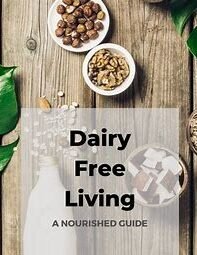Adopting a dairy-free lifestyle can be a great way to improve your health, manage lactose intolerance, or reduce your environmental impact. Whether you’re transitioning for medical reasons, ethical choices, or personal preferences, the good news is that it’s easier than ever to live dairy-free with the wide range of alternatives available today.

1. Know Your Dairy Alternatives
There are plenty of plant-based alternatives to dairy products that are both nutritious and delicious. Familiarize yourself with some of the common dairy-free substitutes:
- Milk Alternatives: Almond milk, soy milk, oat milk, rice milk, coconut milk, and cashew milk are popular dairy-free options. They can be used in coffee, cereal, smoothies, and baking.
- Cheese Alternatives: Many brands offer dairy-free cheeses made from nuts (like cashews), soy, coconut, and even potatoes. You can find cheese substitutes for everything from mozzarella to cream cheese and even grated parmesan.
- Yogurt Alternatives: Coconut milk, soy, almond, and oat-based yogurts are widely available and often come with probiotics, making them a healthy and tasty alternative to dairy-based yogurt.
- Butter Alternatives: You can use plant-based butters made from ingredients like coconut oil, olive oil, or nuts. Vegan margarine or even avocado can serve as an alternative in cooking and baking.
- Ice Cream Alternatives: Dairy-free ice creams made from coconut, almond, or soy milk are delicious substitutes, and many come in a wide range of flavors.
2. Read Labels Carefully
Many processed foods contain hidden dairy ingredients, such as whey, casein, or milk solids. When shopping, it’s important to read labels carefully to ensure the product is truly dairy-free. Look for certifications or labels like “vegan” or “dairy-free” on packaging to make your shopping easier.
Common dairy ingredients to watch out for:
- Casein
- Whey
- Lactose
- Milk solids
- Buttermilk
- Ghee (clarified butter)
- Cheese powder
3. Cook at Home
Preparing meals at home allows you to have complete control over the ingredients you use. You can easily substitute dairy with plant-based ingredients, and cooking at home helps avoid the risk of hidden dairy in restaurant dishes.
- Dairy-Free Baking: In recipes, you can substitute regular butter with vegan butter or oil, milk with plant-based milk, and eggs with egg replacers (such as flaxseed or chia seeds mixed with water, applesauce, or commercial egg replacer).
- Use Nutritional Yeast for Cheese Flavor: Nutritional yeast has a cheesy, nutty flavor and can be used as a topping for popcorn, pasta, or in sauces to add richness without dairy.
4. Keep Healthy Snacks on Hand
It’s easy to reach for packaged snacks when you’re hungry, but many of them may contain hidden dairy. Keep dairy-free snacks on hand to avoid temptation. Some great dairy-free snack ideas include:
- Fresh fruits and vegetables
- Nuts and seeds
- Rice cakes with nut butter
- Granola bars (make sure they’re dairy-free)
- Hummus with veggie sticks or crackers
- Vegan popcorn
5. Find Dairy-Free Comfort Foods
You don’t have to give up your favorite comfort foods just because you’re dairy-free. With some creativity and the right substitutes, you can still enjoy classic meals. Some ideas include:
- Dairy-Free Pizza: Use dairy-free cheese and a vegetable-based or gluten-free crust for a dairy-free pizza.
- Dairy-Free Mac and Cheese: Make a creamy sauce using cashews, nutritional yeast, or blended potatoes to create a rich, cheesy texture without the dairy.
- Dairy-Free Smoothies: Combine fruits, leafy greens, and plant-based milks for a delicious and satisfying dairy-free smoothie.
6. Experiment with New Flavors
Dairy-free living is an opportunity to explore new ingredients and flavors that you may not have considered before. Try incorporating more plant-based foods into your diet, like legumes, quinoa, tofu, and tempeh, and experiment with global cuisines that traditionally don’t rely on dairy (such as many Asian, Mediterranean, and Middle Eastern dishes).
7. Mind Your Calcium and Vitamin D Intake
Dairy is a primary source of calcium and vitamin D for many people. When living dairy-free, it’s essential to ensure you’re getting these nutrients from other sources:
- Calcium-Rich Foods: Leafy greens (such as kale, bok choy, and collard greens), almonds, sesame seeds, chia seeds, fortified plant-based milks, tofu, and beans are all good sources of calcium.
- Vitamin D: Sun exposure is the best natural source of vitamin D, but you can also get it from fortified foods like plant-based milks and cereals, mushrooms, and supplements if necessary.
8. Look for Dairy-Free Restaurants and Cafes
Many restaurants now offer dairy-free options, especially in urban areas. Check out vegan, vegetarian, or health-conscious restaurants that focus on plant-based dishes. In cafes, you can often substitute dairy milk with plant-based alternatives in your coffee or tea. Apps like “HappyCow” or “Dairy-Free Map” can help you find dairy-free-friendly places nearby.
9. Join Online Communities or Support Groups
Transitioning to a dairy-free lifestyle can be challenging, but connecting with others who are on the same journey can provide support, ideas, and recipes. Online communities and social media groups can be helpful for finding advice, products, and inspiration.
10. Be Prepared When Dining Out
When eating at restaurants, always ask your server about the ingredients in dishes and request dairy-free substitutions if necessary. Many restaurants are accommodating of dietary restrictions and will be happy to modify a dish for you.
11. Check for Dairy-Free Supplements
If you need additional nutritional support for your dairy-free lifestyle, consider taking a dairy-free multivitamin or specific supplements. These can help ensure that you’re meeting your nutritional needs for vitamin B12, calcium, and other important nutrients.
Conclusion
Living a dairy-free life is easier than ever thanks to the wide variety of plant-based alternatives and growing awareness of dietary restrictions. With careful planning, meal prep, and label reading, you can thrive without dairy and enjoy delicious, nutritious meals. Whether you’re transitioning for health reasons or just exploring a new lifestyle, the tips and tricks mentioned here can help you create a satisfying and well-rounded dairy-free routine.
